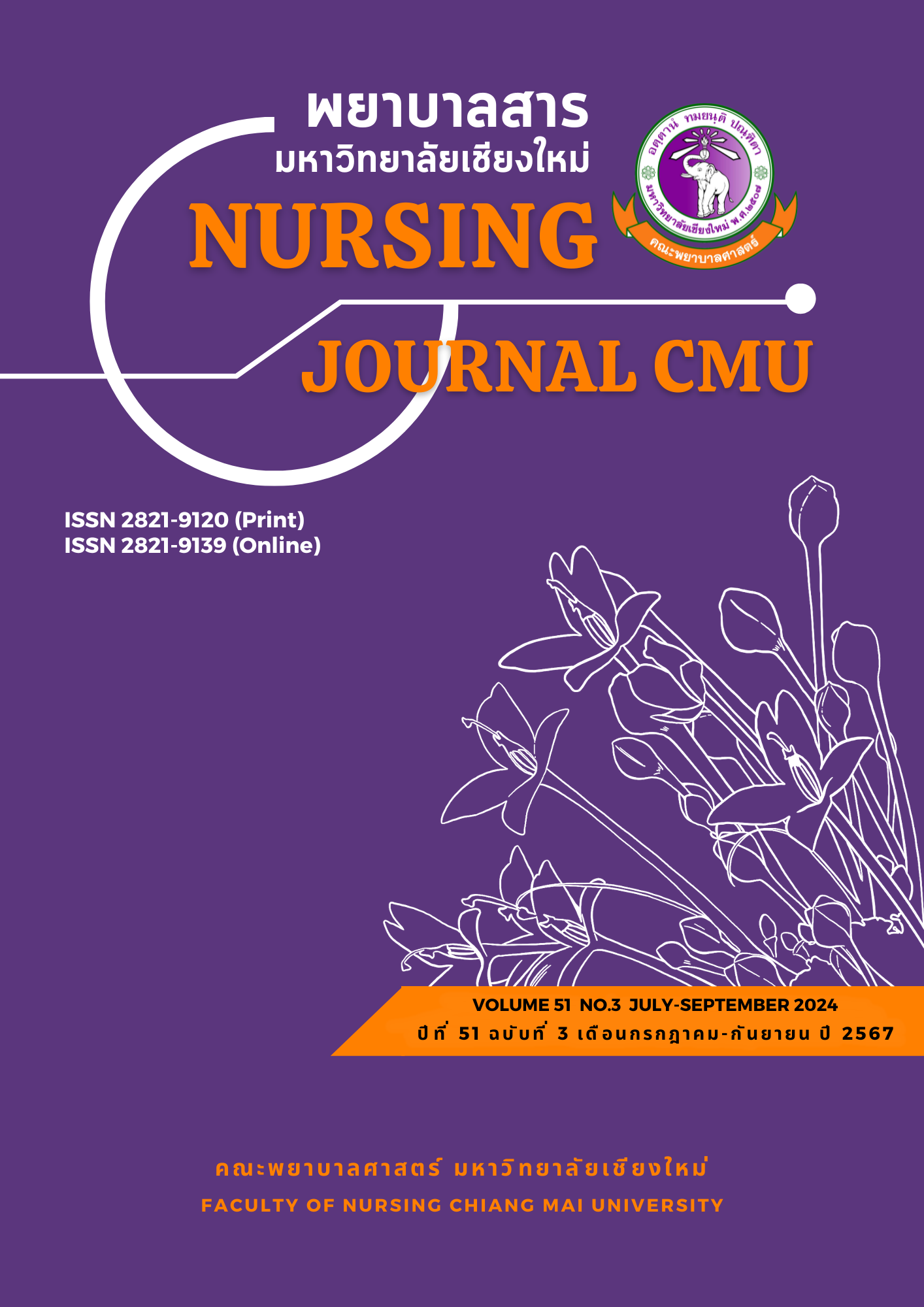Job Crafting and Work Engagement of Nurses in Affiliated Hospitals of Harbin Medical University, the People’s Republic of China
Keywords:
Job crafting, Work engagement, Nurses, The People’s Republic of ChinaAbstract
Job crafting and work engagement are important components of the healthcare system to achieve positive organizational outcomes and quality nursing care. This descriptive correlation study aimed to examine the level of job crafting and work engagement among nurses, and to explore the relationship between job crafting and work engagement. The subjects included 408 nurses working in affiliated hospitals of Harbin Medical University, The People’s Republic of China. Research instruments consisted of the Job Crafting Scale (JCS) developed by Tims et al. and translated into Chinese by Huang et al. and the Utrecht Work Engagement Scale (UWES) developed by Schaufeli et al. and translated into Chinese by Fong and Ng. The Cronbach’s alpha coefficients for the overall JCS and UWES were .97 and .92, respectively. Descriptive statistics and Spearman’s rank-order correlation coefficient were used to analyze data.
The results of this study revealed that nurses perceived their overall job crafting at a high level (M = 3.80, SD = 0.80), and their overall work engagement at an average level (M = 3.66, SD = 1.48). There was a significant, positive relationship between overall job crafting and overall work engagement (rs = 0.68, p < .001).
The results of this study could provide understanding of the relationship between job crafting and work engagement leading to the development of appropriate strategies to enhance work engagement among nurses.
References
Baghdadi, N. A., Farghaly Abd-EL Aliem, S. M. F., & Alsayed, S. K. (2021). The relationship between nurses’ job crafting behaviours and their work engagement. Journal of Nursing Management, 29(2), 214-219. https://doi.org/10.1111/jonm.13141
Crawford, E. R., LePine, J. A., & Rich, B. L. (2010). Linking job demands and resources to employee engagement and burnout: A theoretical extension and meta-analytic test. Journal of Applied Psychology, 95(5), 834–848. https://doi.org/10.1037/a0019364
Cruz, J. P., Alquwez, N., & Balay-Odao, E. (2021). Work engagement of nurses and the influence of spiritual climate of hospitals: A cross-sectional study. Journal of Nursing Management, 30(1), 279-287. https://doi.org/10.1111/jonm.13492
Eltaybani, S., Noguchi-Watanabe, M., Igarashi, A., Saito, Y., & Yamamoto-Mitani, N. (2018). Factors related to intention to stay in the current workplace among long-term care nurses: A nationwide survey. International Journal of Nursing Studies, 80, 118-127. https://doi.org/10.1016/j.ijnurstu.2018.01.008
Fong, T. C. T., & Ng, S. M. (2012). Measuring engagement at work: Validation of the Chinese version of the Utrecht Work Engagement Scale. International Journal of Behavioral Medicine, 19(3), 391-397.
Huang, Q., Wichaikhum, O. A., & Nantsupawat, A. (2020). Job crafting and organizational commitment of nurses in Chengdu University Hospitals, the People’s Republic of China. Nursing Journal, 47(2), 486-501.
Kuijpers, E., Kooij, D. T. A. M., & van Woerkom, M. (2020). Align your job with yourself: The relationship between a job crafting intervention and work engagement, and the role of workload. Journal of Occupational Health Psychology, 25(1), 1-16. https://doi.org/10.1037/ocp0000175
Li, B., Zhang, Q., Li, F., Tang, N. F., Zhang, L., Zang, G., Jia, M., & Lou, X. P. (2021). Analysis of the current situation and influencing factors of 425 emergency department nurses’ work commitment. Journal of Nursing, 23, 62-66. https://doi.org/10.16460/j.issn1008-9969. 2021.23.062 (in Chinese)
Mróz, J., & Kaleta, K. (2016). Relationships between personality, emotional labor, work engagement and job satisfaction in service professions. International Journal of Occupational Medicine and Environmental Health, 29(5), 767–782.
Paulík, K. (2020). Some psychological factors related to work engagement in teachers. The New Educational Review, 59(1), 203-213.
Schaufeli, W., & Bakker, A. B. (2003). Utrecht work engagement scale: Preliminary manual. Occupational Health Psychology Unit, Utrecht University, Utrecht, 26(1), 64-100.
Schaufeli, W. B., Bakker, A. B., & Salanova, M. (2006). Utrecht work engagement scale-9 (UWES-9) [Database record]. APA PsycTests. https://doi.org/10.1037/t05561-000
Schaufeli, W., Salanova, M., González-Romá, V., & Bakker, A. (2002). The measurement of engagement and burnout: A two sample confirmatory factor analytic approach. Journal of Happiness Studies, 3, 71-92. https://doi.org/10.1023/A:1015630930326
Shaheen, R. A., & Mahmoud, S. A. (2021). Relation between job crafting, nurses' job satisfaction and counterproductive work behaviors. Egyptian Journal of Health Care, 12(3), 1497-1515. https://doi.org/10.21608/ejhc.2021.197202
Tims, M., & Bakker, A. B. (2010). Job crafting: Towards a new model of individual job redesign. SA Journal of Industrial Psychology, 36(2), a841. https://doi.org/10.4102/sajip.v36i2.841
Tims, M., Bakker, A. B., & Derks, D. (2012). Development and validation of the job crafting scale. Journal of Vocational Behavior, 80(1), 173–186. https://doi.org/10.1016/j.jvb.2011.05.009
Tong, L. (2018). Relationship between meaningful work and job performance in nurses. International Journal of Nursing Practice, 24(2), e12620. https://doi.org/10.1111/Ijn.12620
Vermooten, N., Boonzaier, B., & Kidd, M. (2019). Job crafting, proactive personality and meaningful work: Implications for employee engagement and turnover intention. SA Journal of Industrial Psychology, 45, a1567. https://doi.org/10.4102/sajip.v45i0.1567
World Health Organization. (2018). Global health workforce statistics database. The global health observatory, World Health Organization. https://www.who.int/data/gho/data/themes/topics/health-workforce
Yamane, T. (1973). Statistic: An introductory analysis. Harper International.
Downloads
Published
How to Cite
Issue
Section
License
Copyright (c) 2024 Nursing Journal CMU

This work is licensed under a Creative Commons Attribution-NonCommercial-NoDerivatives 4.0 International License.
บทความที่ได้รับการตีพิมพ์เป็นลิขสิทธิ์ของวารสารพยาบาลสาร
ข้อความที่ปรากฏในบทความแต่ละเรื่องในวารสารวิชาการเล่มนี้เป็นความคิดเห็นส่วนตัวของผู้เขียนแต่ละท่านไม่เกี่ยวข้องกับมหาวิทยาลัยเชียงใหม่ และคณาจารย์ท่านอื่นๆในมหาวิทยาลัยฯ แต่อย่างใด ความรับผิดชอบองค์ประกอบทั้งหมดของบทความแต่ละเรื่องเป็นของผู้เขียนแต่ละท่าน หากมีความผิดพลาดใด ๆ ผู้เขียนแต่ละท่านจะรับผิดชอบบทความของตนเองแต่ผู้เดียว






